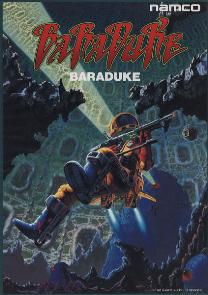Baraduke
| Baraduke | |
|---|---|

Arcade flyer
|
|
| Developer(s) |
Namco Dempa (Sharp X68000) |
| Publisher(s) |
|
| Platform(s) | Arcade, Sharp X68000, Wii (Virtual Console) |
| Release date(s) |
Arcade
|
| Genre(s) | Scrolling shooter |
| Mode(s) | Up to 2 players, alternating turns |
| Cabinet | Upright, cabaret, and cocktail |
| Arcade system | Namco Pac-Land |
| CPU | 1x Motorola M6809 @ 1.536 MHz, 1x Hitachi HD63701 @ 1.536 MHz |
| Sound | 1x Namco WSG @ 1.536 MHz |
| Display | Horizontal orientation, Raster, 288 x 224 resolution |
Baraduke (バラデューク Baradyūku?), also known as Alien Sector, is a scrolling shooter arcade game originally released by Namco in 1985.
The gameplay system is similar to the Metroid series of games. The player takes control of a spacewoman in a biohazard suit, Player 1 is Kissy and Player 2 is Takky. They must clear eight worlds of increasing difficulty (each one is composed of five regular floors and one boss floor) by using their wave guns to destroy all the enemies populating them. They must also save the one-eyed Paccets for extra points and the chance to earn another shield in the end-of-floor bonus games.
On each floor there are a certain amount of enemies known as Octy, which will leave power-up capsules behind when defeated. Defeating all the Octy on the current floor will open up a pipe at the bottom of the floor, and the player will have to find and enter it in order to proceed to the next one. The boss floors feature a giant enemy (a Blue Worm in Worlds 1, 3, 5 and 7, a Turning Eye in Worlds 2, 4 and 6, and the Octy Kin' himself in World 8) who must be killed in order to proceed to the next world.
Baraduke runs on Namco Pac-Land hardware, but with a video system like that used in Metro-Cross and Dragon Buster (modified to support vertical scrolling and a 2048-color palette). In 1995, ten years after its original arcade release, it was ported to the Sharp X68000, and was also included in the fifth volume of the Namco Museum series on the PlayStation.
A sequel titled Bakutotsu Kijūtei was released in 1988, but only in Japan. It was the second game from the company to allow scores not ending in "0" (the first was Hopping Mappy, which was released in 1986).
...
Wikipedia
